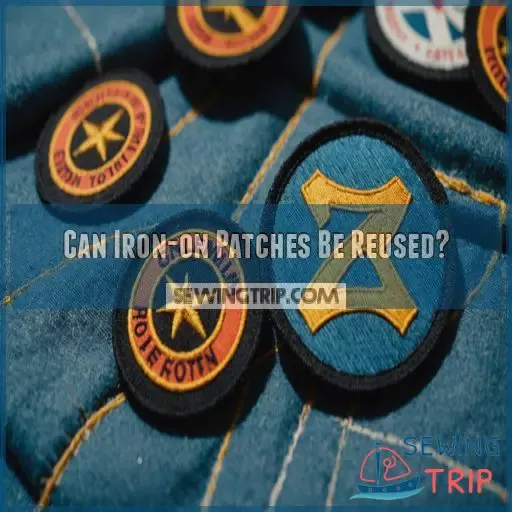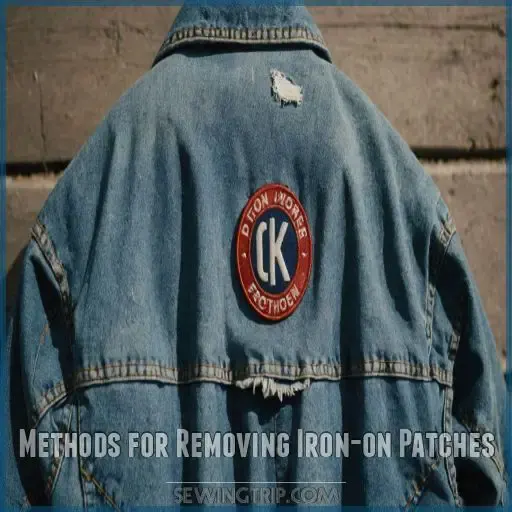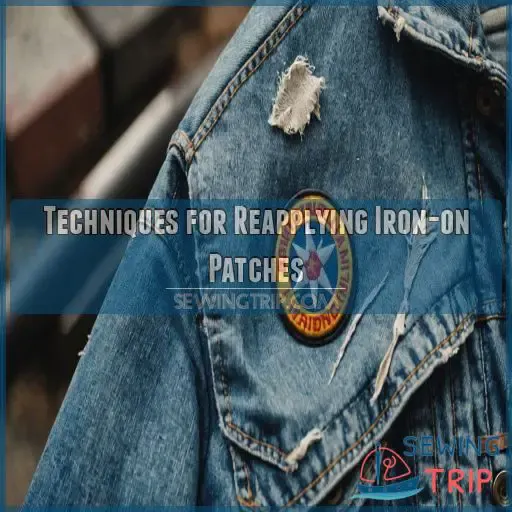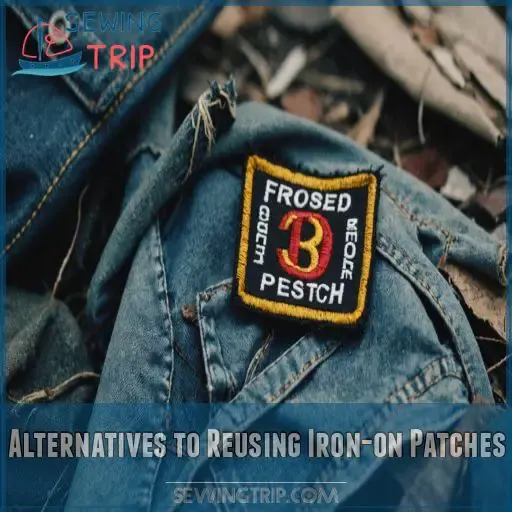This site is supported by our readers. We may earn a commission, at no cost to you, if you purchase through links.
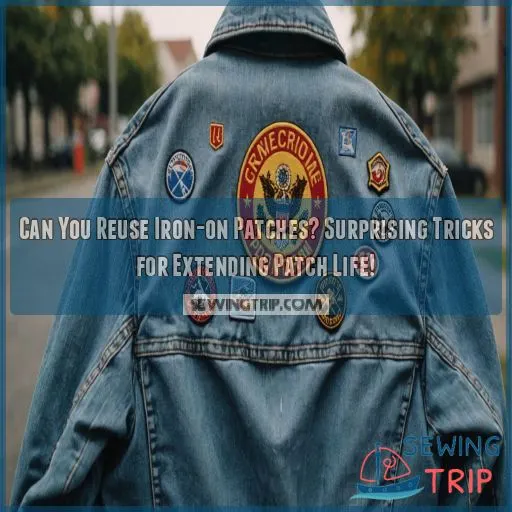 Yes, you can reuse iron-on patches! These versatile embellishments aren’t one-and-done deals.
Yes, you can reuse iron-on patches! These versatile embellishments aren’t one-and-done deals.
With a bit of know-how, you’ll be recycling patches like a pro. Start by carefully removing the patch using heat or adhesive remover.
Once off, you’re free to give it a new home on another garment. Just position it, apply heat, and voila! Your trusty patch gets a second life.
It’s like giving your favorite design superpowers to travel from shirt to jacket to bag. But that’s not all – there are some clever tricks to extend your patch’s lifespan and even more creative ways to repurpose them. Who knew these little fabric squares could be so adaptable?
Table Of Contents
Key Takeaways
- You’re not stuck with a one-and-done deal – iron-on patches can indeed be reused. With a bit of patience and know-how, you can give your favorite designs a second (or third) life on a new garment. Just remember, they might be a tad less sticky on their encore performance.
- Don’t let those patches go down without a fight. On average, they’ll stick around for about 25 washes before waving the white flag. But fear not, patch enthusiast. With some TLC and clever tricks like reinforcing stitches, you can extend their lifespan and keep rocking that cool design long after laundry day.
- Got a patch that’s seen better days? Don’t toss it in the bin just yet. Get your creative juices flowing and turn it into a piece of art. Frame it, quilt it, or transform it into a funky accessory. Who knew your old band patch could become a conversation-starting piece of jewelry?
- When it comes to reapplying patches, think of yourself as a fashion surgeon. Carefully remove the old patch with heat or adhesive remover, prep your new garment like you’re prepping for surgery, and apply that patch with precision. Just remember, a little extra TLC goes a long way in ensuring your reused patch sticks around for the long haul.
Can Iron-on Patches Be Reused?
You might be surprised to learn that iron-on patches can indeed be reused with some clever techniques.
Whether you’re looking to save money, reduce waste, or preserve a cherished design, this guide will show you how to breathe new life into those old patches you thought were destined for the trash.
Lifespan of Iron-on Patches
Ever wonder how long those iron-on patches will stick around?
Well, you’re in for a treat! On average, these little beauties can last for about 25 washes before they start to wave goodbye.
But don’t fret! With some TLC and savvy techniques, you can extend their lifespan and keep your favorite designs looking fresh.
Ready to become a patch preservation pro? Let’s get started!
Factors Affecting Patch Reusability
The lifespan of your iron-on patches isn’t set in stone.
Several factors can affect their reusability:
- Patch type: Embroidered vs. printed designs
- Adhesive strength: Quality of the original bonding
- Fabric type: Cotton, polyester, or blends
- Washing frequency: More washes = less stickiness
Your patch’s journey doesn’t end after its first use.
With a little TLC, you might just breathe new life into that beloved design.
Let’s explore how to make your iron-on patches go the extra mile!
Assessing Patch Condition for Reuse
Checking your iron-on patch’s condition is important before reusing it.
You’ll want to check for adhesive integrity, fabric wear, and color fading.
Run your fingers along the edges – are they fraying?
Examine the stitching closely.
Has the patch maintained its original size and shape?
If it’s still in good nick, you’re golden!
But remember, even a slightly damaged patch might find new life in a creative project.
Benefits of Reusing Iron-on Patches
Reusing iron-on patches isn’t just about saving money; it’s a step in the direction of a more sustainable lifestyle.
You’ll reduce waste, breathe new life into old garments, and flex your creative muscles.
Imagine turning a beloved childhood patch into a cherished accessory or giving your favorite jacket a fresh look.
Plus, you’ll master the art of patch removal and reapplication, a skill that’ll serve you well in your eco-friendly fashion journey.
Methods for Removing Iron-on Patches
Now that you know iron-on patches can be reused, let’s tackle the tricky part: removal.
Don’t worry, it’s not rocket science!
First, channel your inner detective and assess your garment’s heat tolerance.
Give it a quick iron test in a hidden spot – better safe than sorry!
Once you’ve got the all-clear, grab a trusty dishcloth or wax paper and play iron-on patch peekaboo.
Press that hot iron down for 15-20 seconds, and voila!
If your patch is being stubborn, don’t throw in the towel just yet.
Time to bring out the big guns: adhesive remover or rubbing alcohol.
But remember, always test these on a small area first – we’re not playing patch roulette here!
After you’ve won the battle against the clingy patch, give your garment a good wash.
No dryer until it’s squeaky clean!
Techniques for Reapplying Iron-on Patches
You might think iron-on patches are one-and-done, but guess what?
With a little know-how, you can breathe new life into those beloved badges and give them a second home on a fresh garment.
Preparing the New Garment
You’ve successfully removed your old patch, but hold your horses! Before slapping it on a new garment, let’s get that fabric prepped for its makeover. Here’s your game plan:
- Check the fabric type – cotton’s your best friend here
- Give it a good pre-wash to avoid shrinkage surprises
- Set up a sturdy ironing surface – no wobbly boards allowed!
Positioning the Reused Patch
After prepping your garment, it’s time to position your reused patch like a pro. The key is precision and patience. Here’s a handy guide to help you nail the placement:
| Surface | Alignment | Tip |
|---|---|---|
| Flat | Centered | Use ruler |
| Curved | Follow contour | Pin in place |
| Textured | Avoid seams | Test first |
| Stretch | Allow extra space | Use stabilizer |
Applying Heat and Pressure
Once you’ve got your patch in place, it’s time to turn up the heat! Set your iron to medium-high and cover the patch with a thin cloth.
Press down firmly for about 30 seconds, channeling your inner superhero strength. Remember, you’re not trying to flatten a pancake – just enough pressure to make that patch stick like glue.
Let it cool before you admire your handiwork!
Ensuring Proper Adhesion
Now that you’ve applied heat and pressure, let’s make sure that patch sticks like glue! Proper adhesion is key to giving your reused iron-on patch a new lease on life. Here are some tricks to help your patch stay put:
- Check for air bubbles and smooth them out
- Allow the patch to cool completely before handling
- Test the edges for loose spots
- Apply extra heat to stubborn areas
- Use a clean cloth to press down firmly
Alternatives to Reusing Iron-on Patches
If you’ve got a beloved iron-on patch that’s seen better days, don’t toss it just yet!
There are plenty of creative alternatives to reusing these patches that’ll let you keep cherishing those memories while giving them a whole new life.
Creating Memory Quilts
Creating a memory quilt is a fantastic way to breathe new life into your iron-on patches.
You’ll transform cherished memories into a cozy keepsake that tells your unique story.
Here’s a quick guide to get you started:
| Step | Materials | Techniques |
|---|---|---|
| 1. Gather | Patches, fabric | Sort by theme |
| 2. Design | Graph paper, pencil | Sketch layout |
| 3. Assemble | Sewing machine, thread | Piece together |
Don’t let those patches gather dust – turn them into a snuggly masterpiece you’ll treasure for years!
Framing Patches as Artwork
Memory quilts are wonderful, but why not showcase your favorite patches as wall art? You’ll love the visual impact of framed iron-on patches!
Grab a shadowbox frame, arrange your patches creatively, and secure them with pins or adhesive.
This eye-catching display preserves your cherished memories but also adds a unique touch to your decor.
It’s a conversation starter that’ll make you smile every time you see it!
Repurposing Patches for Crafts
Got old patches lying around? Don’t toss them! Transform those vintage beauties into eye-catching crafts. Whip up a cozy patch quilt, stitch a funky patch collage onto a tote bag, or create unique jewelry pieces. You’d be surprised how iron-on patches can breathe new life into plain accessories. With a little creativity and some basic sewing skills, you’ll discover a world of patch art possibilities explore diverse textures, hues, and color theory.
Extending the Life of Iron-on Patches
Want to get more mileage out of your iron-on patches?
You’re in luck – with a few simple tricks, you can extend the life of these decorative gems and keep your favorite designs looking fresh for longer.
Proper Care and Maintenance
Breathe new life into your beloved iron-on patches with proper care and maintenance!
Start by washing your patched garments inside out in cold water, using a gentle cycle.
When ironing, place a thin cloth over the patch to protect it from direct heat.
Store patched items flat or hanging to prevent creasing.
For stubborn dirt, spot clean with a soft brush and mild detergent.
With these tricks, you’ll keep your patches looking fresh and fabulous!
Reinforcing With Stitching
Once you’ve mastered proper care, it’s time to level up your patch game.
Want to make those iron-on beauties last even longer? Grab a needle and thread! By reinforcing the edges with simple stitches, you’ll give your patches superpowers.
Choose a thread color that matches or complements your patch, and use a backstitch or whipstitch for extra strength. It’s like giving your patch a bulletproof vest!
Spot Cleaning Techniques
Now that you’ve reinforced your patches, let’s talk about keeping them clean.
Spot cleaning is your secret weapon for extending patch life.
You’ll want to tackle stains ASAP, using a gentle touch.
Dab, don’t rub, with a mild detergent solution.
For stubborn marks, try a fabric-specific cleaner.
Remember, prevention is key – pre-wash your garments and avoid spills to keep those patches looking sharp!
Creative Ways to Reuse Iron-on Patches
Don’t let those beloved iron-on patches go to waste just because you’ve outgrown a garment.
With a little creativity, you can breathe new life into old patches by upcycling clothing, designing eye-catching collages, or even incorporating them into unique accessories.
Upcycling Clothing With Reused Patches
Upcycling clothing with reused patches is a fun way to breathe new life into your wardrobe.
You’ll be amazed at how a few strategically placed patches can transform an old garment.
Here are three patch-upcycling trends to try:
- Cover stains or holes with eye-catching patches
- Create a themed jacket by grouping similar patches
- Add personality to plain items with quirky, mismatched patches
Get creative and let your patch-reuse inspiration run wild!
Designing Patch Collages
Ready to take your patch game to the next level? Designing patch collages lets you express your creativity and give old iron-ons new life.
Start by laying out your patches on a backing fabric, playing with different color themes and compositions.
Mix sizes and shapes for visual interest, and don’t be afraid to overlap!
Use fabric glue or stitching to secure your masterpiece, then proudly display your unique creation.
Incorporating Patches Into Accessories
After creating stunning patch collages, why stop there?
Your accessories are begging for a patch makeover!
Transform plain bags into conversation starters with strategically placed iron-ons.
Jazz up boring hats or belts with eye-catching designs.
Feeling crafty?
Whip up unique patch-embellished jewelry or funky keychains.
The possibilities are endless!
With a little creativity, you’ll breathe new life into old patches and give your accessories a personal touch that screams "uniquely you.
Frequently Asked Questions (FAQs)
Can iron-on patches be reapplied?
You can reapply iron-on patches, but it’s a bit tricky.
Heat ’em up, peel ’em off carefully, and give them a new home on fresh fabric.
Just remember, they might not stick as well the second time around.
Can you iron on a patch twice?
It’s tricky, but not impossible! Reheating your iron-on patch can work, though it might not stick as well the second time.
For best results, consider sewing it on for added durability and a longer-lasting fix.
Can you iron a patch over a patch?
While tempting, layering patches isn’t recommended.
The heat might damage the first patch or create uneven surfaces.
Instead, carefully remove the original patch and apply the new one for a clean, professional look.
Experiment on scrap fabric first!
Is there a backing on an iron-on patch?
Iron-on patches come with a heat-activated adhesive backing.
This clever feature allows you to easily attach the patch to your garment.
Simply position it, apply heat with an iron, and voila! Your patch becomes a permanent fixture.
How long do iron-on patches typically last?
Time flies when you’re rocking iron-on patches!
You’ll typically get around 25 washes before they start to peel.
Want them to stick around longer? Consider sewing them on for extra staying power.
Can iron-on patches be applied to all fabrics?
You can’t slap iron-on patches onto just any fabric.
They work best on sturdy materials like cotton, denim, or polyester.
Delicate fabrics might not hold up, so test a small area first to avoid a fashion faux pas.
Are there eco-friendly alternatives to iron-on patches?
Looking for greener options? Consider embroidered patches, fabric paint, or appliqué techniques.
These eco-friendly alternatives don’t require adhesives and can be easily removed or updated.
Plus, they’re a great way to flex your creative muscles and personalize your gear.
Can iron-on patches be customized or personalized?
Got a blank canvas? Your iron-on patches can be as unique as your fingerprint!
Customize them with personal designs, names, or logos.
Companies like Nanjing Jiamei offer custom embroidery and silkscreen options to make your patches truly one-of-a-kind.
Do iron-on patches work on stretchy materials?
Iron-on patches can be tricky on stretchy fabrics. They’ll stick initially, but might crack or peel with movement.
For lasting results, consider sewing the patch on or using a flexible adhesive designed for stretchy materials.
Conclusion
Who knew those little fabric squares could hold such big potential?
Now that you’ve learned how to reuse iron-on patches, your favorite designs can enjoy multiple lives across your wardrobe.
Whether you’re giving new life to an old jacket or creating unique accessories, the possibilities are endless.
Remember, with proper care and a bit of creativity, you can extend your patches’ lifespan far beyond their first application.
So go ahead, embrace your inner patch recycler and let your style evolve with every reuse!

